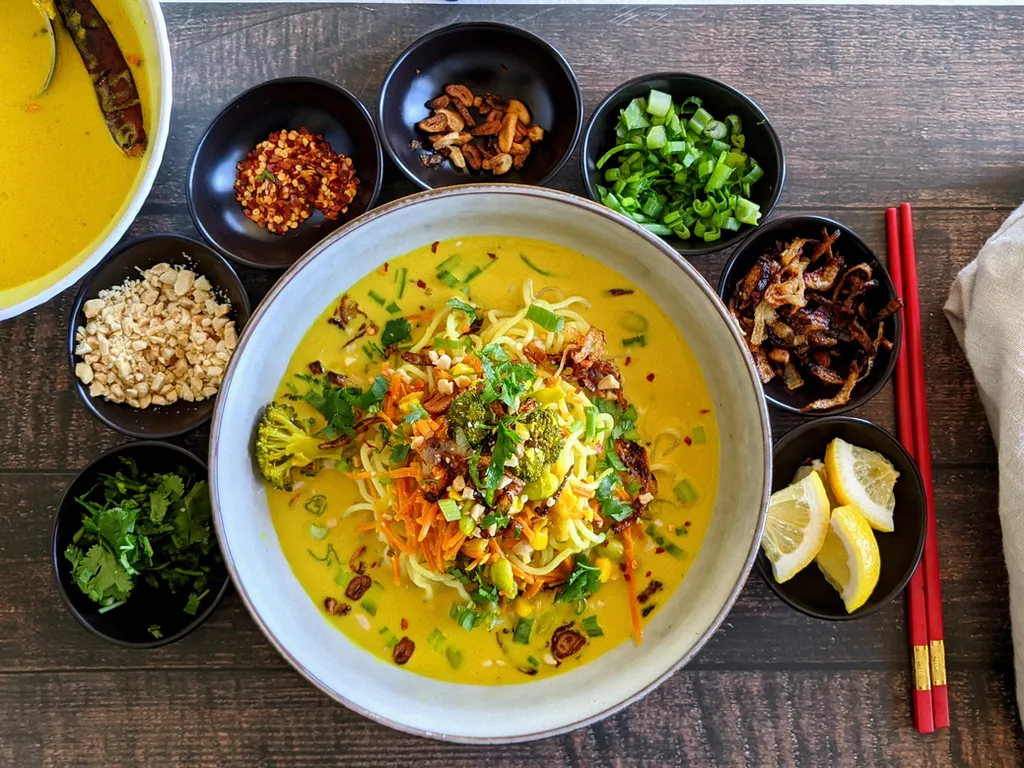Burmese Khao Suey – ONE-POT COMFORT!
Burmese Khao Suey is a tasty noodle dish that can be accompanied by various condiments. If you like Burmese food, you should try this Burmese Khao Suey soup at least once. There are numerous Khao Suey recipes, and people worldwide have adapted them to their local preferences and readily available ingredients.
This noodle soup will feel like a bowl of happiness on a cold rainy day if you’re looking for a comforting soupy noodle dish. Burmese Khao Suey Restaurant style is traditionally made with chicken, meat, or eggs. Still, this vegan version includes vegetables cooked in coconut milk soup, such as mushrooms, carrots, and spring onions. Each spoonful of this soup will provide you with a flavour explosion.
Don’t worry if you’re wondering how to make Burmese Khao Suey at home; we’ve got you covered. For your convenience, here’s a quick Burmese Khao Suey video that will walk you through the entire process. If you want to make Burmese Khao Suey at home, you can change the ingredients to suit your tastes. This flavorful noodle soup not only comes together in a single pot with plenty of delicious veggies but is also straightforward to make and takes very little time. You can make it even healthier by using brown rice.
What Exactly is Khow Suey?
The Burmese Khow Suey is the ideal comfort food when feeling under the weather. This flavorful soup, made with noodles, coconut milk, and vegetables, combines health and taste perfect. The main reason the Burmese Khow Suey has won so many fans is because of its intense flavour. A bowl of this delicious soup will have you up and running in no time, ready to take on the world. People can experiment with different flavours and textures because it’s served with various garnishes and toppings. It’s like a mini-adventure for your taste buds.
The History of Burmese Khow Suey
Myanmar is thought to be the origin of the Burmese Khow suey (Burma). People who migrated to East India during WWII brought the Khao suey recipe. One of the main reasons the Burmese Khao suey became popular was that it met the essential taste criteria of salty, sour, sweet, and umami. It is a popular street food, particularly in North East India.
The ingredients for the Khao suey recipe are readily available in the Indian subcontinent. This has resulted in various variations of the original Burmese Khao suey recipe, such as chicken Khao suey. According to Thant Myint-book U’s “The River of Lost Footsteps,” the arrival of the British in Rangoon, Myanmar, in the nineteenth century resulted in establishing of several trade houses. It allowed many Indians to travel to Burma to earn a living while remaining close to their families.
These Indians enjoyed the delicious Burmese Khow Suey, and they soon took the recipe home when they left to visit their families. So this is how this delectable noodle recipe spread throughout the Indian subcontinent.
In fact, innovative Indians have reinvented the Burmese Khao suey in a variety of ways, resulting in a variety of versions, including a vegan version.
How Should You Eat Khao Suey?
For anyone who has had the pleasure of tasting this delectable noodle soup, the Burmese Khow Suey has become synonymous with comfort food. But did you know that the term “Khow Suey” refers to the noodles used in the recipe?
Many people use the term Khow Suey to refer to the famous noodle soup dish, just as the word curry has become the go-to word to describe any gravy.
However, the versatile Khao suey is used in many dishes.
- According to the authentic Burmese Khao suey recipe, you should eat this bowl of sunshine by ladling the thick, rich gravy over thin rice noodles and then topping it with your favourite condiments.
- You can get roasted and crushed peanuts, red and green chilli flakes, cumin seeds, fried onion slices, lemon wedges, fresh coriander leaves, halved-boiled eggs, and soy sauce.
- A delicious bowl of Khao suey veg soup is available at any time of the day. The vegetarian Khao suey recipe consists of noodles, soup, and vegetables and is an excellent addition to any meal plan.
- It is also a healthy recipe that will help you keep track of your calorie intake. Learning how to make Khao suey can help you improve your culinary skills and wow your guests the next time you host a dinner party at your house.
- Serve some delicious Burmese Khao suey in individual bowls and provide a selection of condiments for your guests to choose from. This exotic dish that has stood the test of time will astound them.
How to Make the Best Khao Suey
If you want to improve your Burmese Khao suey, you’ve come to the right place! Here are a few pointers gleaned from professional chefs and home cooks:
- Always use fresh Burmese Khao suey ingredients when making this delectable noodle soup. Each component has an impact on the flavour of the finished product!
- To achieve the desired consistency of the Burmese Khao suey, use thick coconut milk.
- For an extra nutty flavour, thicken the soup with gram flour.
- By adding the appropriate amount of proteins, such as chicken, halved boiled eggs, prawns, or tofu chunks, the Burmese Khao suey can be transformed into a well-balanced meal.
- Whole wheat, rice, or egg noodles can be used in the Burmese Khao suey recipe. You have a choice.
- Keep in mind not to overcook the noodles. It can result in a mushy, unappealing soup.
- Toppings such as fried shallots, sliced onions, fresh ginger, fried garlic, chips, lemon wedges, finely chopped green chillies, chopped spring onions, crushed chilli flakes, crispy fried noodles, chopped coriander or cilantro, and crushed peanuts can be added to the dish.
- Serve a large bowl of Burmese Khow Suey alongside a couple of small bowls filled with the previously mentioned toppings.
- To add flavour and texture to this delicious and rich noodle soup, add your favourite vegetables.
- The key to making the perfect bowl of Burmese Khow Suey is to use the correct proportions of ingredients so that the flavours do not clash.
- This dish freezes well and can be easily made in bulk and frozen.
- It is helpful if you prefer to prepare your meals for the week ahead of time.
Nutrition Info. (per serving)
- 282 CALORIES
- 11g PROTEIN
- 14g FAT
- 23g CARBS
- 6g FIBER






